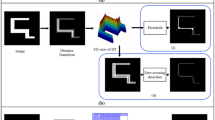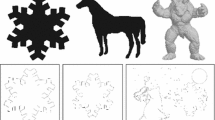Abstract
Since the early days of computer vision research, shape from contour has been one of the most challenging problems. Many researchers in the field have attempted to understand this problem and proposed different approaches to solve it. Shape from contour still remains one of the hardest problems in the field. The problem has two major difficulties. First, 2D properties of contours of viewed objects are generally not sufficient by themselves to uniquely determine 3D shape, as one dimension is lost in the projection. Second, real images produce imperfect contours that make their interpretation particularly difficult. The first problem has received some attention in the research community but in the context of perfect contours. The second one, however, has received very little.
In this work, we propose a promising methodology to address this last problem for a large class of objects: generalized cylinders. It is based on exploiting mathematical invariant properties of the contours of generalized cylinders in a perceptual grouping approach. We show that using these properties greatly helps addressing the figure-ground problem in a more rigorous way than previous (intuitive) perceptual grouping methods. Our approach exploits the interplay between local and global features by handling different levels of the feature hierarchy. We have developed and implemented a method that handles SHGCs in complex seenes with markings and occlusion.
We demonstrate the application of our method of shape description and scene segmentation on complex real images. We also demonstrate the usage of the obtained descriptions for recovery of complete 3-D object centered descriptions of viewed objects from a single intensity image.
Similar content being viewed by others
Explore related subjects
Discover the latest articles, news and stories from top researchers in related subjects.References
Barrow, H.G. and Teneubaum, J.M. 1981. Interpreting line drawings as three dimensional surfaces. Artificial Intelligence, 17:75–116.
Bartels, D.H., Beatty, J., and Barsky, B. 1987. An Introduction to Splines for use in Computer Graphics and Applications. Morgan Kaufmann Publishers, Inc.
Biederman, I. 1987. Recognition by components: A theory of human image understanding. Psychological Review, 94(2):115–147.
Binford, T.O. 1971. Visual perception by computer. IEEE Conference on Systems and Controls, Miami.
Binford, T.O. 1981. Inferring surfaces from images. Artificial Intelligence, 17:205–245.
Binford, T.O. 1991. Inverse generalized cylinders: Inverse generalized transformational invariance and quasi-invariance. In Proceedings of Darpa-Esprit Workshop on Invariance in Computer Vision.
Brooks, R.A. 1983. Model-based three dimensional interpretation of two dimentional images. IEEE Transactions on Pattern Analysis and Machine Intelligence, 5(2):140–150.
Canny, J.F. 1986. A computational approach to edge detection. IEEE Transactions on Pattern Recognition and Machine Intelligence, 8(6):679–698.
Clowes, M.B. 1971. On seeing things. Artificial Intelligence, 2(1):79–116.
Do Carmo, M.P. 1976. Differential Geometry of Curves and Surfaces. Prentice Hall.
Dolan, J. and Weiss, R. 1989. Perceptual grouping of curved lines. In Proceedings of the Image Understanding Workshop, Palo Alto, California, pp. 1135–1145.
Gross, A. and Boult, T. 1990. Recovery of generalized cylinders from a single intensity view. In Proceedings of the Image Understanding Workshop, Pennsylvania, pp. 557–564.
Horaud, R. and Brady, M. 1988. On the geometric interpretation of image contours. Artificial Intelligence, 37:333–353.
Horn, B.K.P. 1986. Robot Vision. M.I.T. Press: Cambridge, MA.
Hummel, J.E. and Biederman, I. 1992. Dynamic binding in a neural network for shape recognition. Psychological Review.
Kanade, T. 1981. Recovery of the three-dimensional shape of an object from a single view. Artificial Intelligence, 17:409–460.
Koenderink, J.J. 1990. Solid Shape. M.I.T. Press: Cambridge, MA.
Lowe, D.G. 1985. Perceptual Organization and Visual Recognition. Kluwer Academic Publishers: Hingham, MA.
Mackworth, A.K. 1973. Intrepreting pictures of polyhedral scenes. Artificial Intelligence, 4:121–137.
Malik, J. 1987. Interpreting line drawings of curved objects. International Journal of Computer Vision, I(1):73–103.
Marr, D. 1977. Analysis of oceluding contour. In Proceedings of the Royal Society of London, B197:441–475.
Mohan, R. and Nevatia, R. 1989. Segmentation and description of scenes using perceptual organization. In Proceedings of IEEE Computer Vision and Pattern Recognition, pp. 333–341.
Nalwa, V. 1989. Line drawing interpretation: Bilateral symmetry. IEEE Transactions on Pattern Analysis and Machine Intelligence, 11:1117–1120.
Nevatia, R. and Binford, T.O. 1977. Description and recognition of complex curved objects. Artificial Intelligence, 8(1):77–98.
Nevatia, R. 1982. Machine Perception. Prentice Hall.
Nevatia, R., Price, K., and Medioni, G. 1992. USC image understanding research: 1990–1991. In Proceedings of the Image Understanding Workshop, San Diego, California.
Ponce, J. and Chelberg, D. 1987. Finding the limbs and cusps of generalized cylinders. International of Computer Vision, 1:195–210.
Ponce, J., Chelberg, D., and Mann, W.B. 1989. Invariant properties of straight homogeneous generalized cylinders and their contours. IEEE Transactions on Pattern Analysis and Machine Intelligence, 11(9):951–966.
Rao, K. and Medioni, G. 1988. Useful geometric properties of the generalized cone. In Proceedings of IEEE Computer Vision and Pattern Recognition, pp. 276–281.
Rao, K. and Nevatia, R. 1989. Description of complex objects from incomplete and imperfect data. In Proceedings of the Image Understanding Workshop, Palo Alto, California, pp. 399–414.
Richetin, M., Dhome, M., Lapestre, J.T., and Rives, G. 1991. Inverse perspective transform using zero-curvature contours points: Applications to the localization of some generalized cylinders from a single view. IEEE Transactions on Pattern Analysis and Machine Intelligence, 13(2):185–192.
Saint-Mare, P. and Medioni, G. 1990. B-spline contour representation and symmetry detection. In First European Conference on Computer Vision, Antibes, France, pp. 604–606.
Sato, H. and Binford, T.O. 1992a. On finding the ends of SHGCs in an edge image. In Proceedings of the Image Understanding Workshop, San Diego, California.
Sato, H. and Binford, T.O. 1992b. BUILDER-I: A system for the extraction of SHGC objects in an edge image. In Proceedings of the Image Understanding Workshop, San Diego, California.
Shafer, S.A. 1983. Shadow geometry and occluding contours of generalized cylinders. Technical Report CS-83-131, Carnegie Mellon University.
Shafer, S.A. and Kanade, T. 1983. The theory of straight homogeneous generalized cylinders. Technical Report CS-083-105, Carnegie Mellon University.
Ulupinar, F. 1991. Perception of 3-D shape from 2-D image of contours. Ph.D. thesis. University of Southern California.
Ulupinar, F. and Nevatia, R. 1990a. Shape from contours: SHGCs. In Proceedings of IEEE International Conference on Computer Vision, Osaka, Japan, pp. 582–582.
Ulupinar, F. and Nevatia, R. 1990b. Inferring shape from contours for curved surfaces. In Proceedings of International Conference on Pattern Recognition, Atlantic City, NJ, pp. 147–154.
Ulupinar, F. and Nevatia, R. 1991b. Recovering shape from contour for constant cross section generalized cylinders. In Proceedings of Computer Vision and Pattern Recognition, Maui, Hawali, pp. 674–676.
Ulupinar, F. and Nevatia, R. 1992. Recovery of 3-D objects with multiple curved surfaces from 2D contours. In Proceedings of the Image Understanding Workshop, San Diego, California.
Witkin, A.P. 1981. Recovering surface shape and orientation from texture. Artificial Intelligence, 17:17–45.
Witkin, A.P. and Tenenbaum, J.M. 1983. On the role of structure in vision. In J.Beck, B.Hope, and A.Rosenfeld (Eds.), Human and Machine Vision, Academic Press: New York, pp. 481–543.
Zerroug, M. and Nevatia, R. 1993a. Scene segmentation and volumetric descriptions of SHGCs from a single intensity image. To appear in Proceedings of the Third European Conference on Computer Vision, Stockholm, Sweden (also in Proceedings of the Image Understanding Workshop, Washington, DC).
Zerroug, M. and Nevatia, R. 1993b. Quasi-invariant properties and 3-D shape recovery of non-straight, non-constant generalized cylinders. In Proceedings of Computer vision and Pattern Recognition, New York (also in Proceedings of the Image Understanding Workshop, Washington, DC).
Zerroug, M. and Nevatia, R. 1993c. Using invariance and quasiinvariance for the segmentation and recovery of curved objects. In Proceeding of the Second ARPA/NSF ESPRIT Workshop on the Applications of Invariance in Computer Vision, The Azores.
Author information
Authors and Affiliations
Additional information
This research was supported by the Advanced Research Projects Agency of the Department of Defense and was monitored by the Air Force Office of Scientific Research under Contract No. F49620-90-C-0078. The United States Government is authorized to reproduce and distribute reprints for governmental purposes notwithstanding any copyright notation hereon.
Rights and permissions
About this article
Cite this article
Zerroug, M., Nevatia, R. Volumetric descriptions from a single intensity image. Int J Comput Vision 20, 11–42 (1996). https://doi.org/10.1007/BF00144115
Received:
Revised:
Issue Date:
DOI: https://doi.org/10.1007/BF00144115




